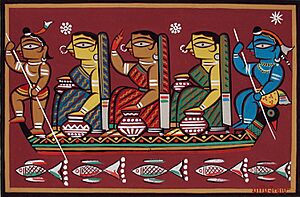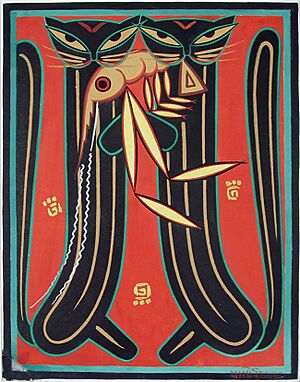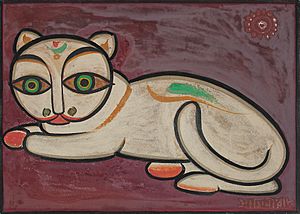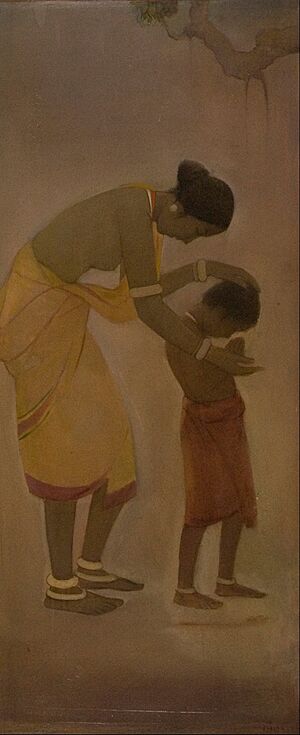Jamini Roy facts for kids
Quick facts for kids
Jamini Roy
|
|
|---|---|
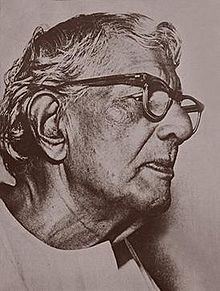 |
|
| Born | 11 April 1887 Beliatore, Bankura district, Bengal Presidency, British Raj
|
| Died | 24 April 1972 (aged 85) |
| Nationality | Indian |
| Alma mater | Government College of Art, Kolkata |
| Known for | Painting |
| Awards | Padma Bhushan (1954) |
Jamini Roy (born 11 April 1887 – died 24 April 1972) was a famous Indian painter. He was honored with the Padma Bhushan award in 1954. This is one of the highest awards given by the Government of India. Jamini Roy was a well-known student of Abanindranath Tagore. Tagore was another respected Indian artist and teacher.
Contents
Jamini Roy's Early Life
Jamini Roy was born on April 11, 1887. His family lived in a village called Beliatore in West Bengal. They were landowners and loved art. This artistic home helped shape his future choices.
When he was sixteen, Jamini Roy went to study art. He joined the Government College of Art, Kolkata. There, Abanindranath Tagore was a vice-principal. Tagore was also the founder of the Bengal school of art.
Jamini Roy soon realized something important. He felt he should get ideas from his own culture. He looked at folk art and tribal art for inspiration. He was especially influenced by Kalighat Pat. This art style used bold, sweeping brush-strokes. He stopped painting Western-style landscapes and portraits. Between 1921 and 1924, he began trying new things. He started with the Santhal dance as a theme.
Jamini Roy's Unique Art Style
Jamini Roy started his career painting portraits for money. But in the early 1920s, he stopped. He wanted to find his own special way of painting.
He changed his style completely. He moved away from his Western art training. Instead, he created a new style. This style was based on traditional Bengali folk art.
People sometimes called Roy an "art machine." This is because he made about 20,000 paintings in his life! That's like 10 paintings every day. But his artistic goals always stayed the same. He wanted ordinary middle-class people to enjoy his art. He believed these people were more important than governments. They were the true voice of his art.
Roy had three main goals with his art:
- To show the simple beauty of folk people's lives.
- To make art available to more people.
- To give Indian art its own special look.
Jamini Roy's paintings were first shown in Kolkata in 1938. In the 1940s, he became very popular. Many people from the Bengali middle class bought his art. Europeans also became his customers. His work was shown in London in 1946. In 1953, it was shown in New York City.
He preferred to be called a "patua." A patua is a traditional folk artist. Jamini Roy spent most of his life living and working in Kolkata. His artworks are now in many museums and galleries worldwide. This includes the Victoria and Albert Museum in London.
Awards and Honors
Jamini Roy received several important awards for his art:
- In 1934, he won a Viceroy's gold medal. This was at an all-India art exhibition.
- In 1955, the Government of India gave him the Padma Bhushan. This is the third highest award for civilians in India.
- In 1956, he became a Fellow of the Lalit Kala Akademi. This is the highest honor for fine arts in India.
Famous Artworks by Jamini Roy
Jamini Roy created many memorable paintings. Here are a few of his key works:
- "Ramayana" (1946): This is considered his greatest work. It is a series of 17 paintings. Each painting is about 106 x 76 cm. Roy painted this series in the Kalighat pata style. He used natural colors made from earth, chalk, and vegetables. The story of Ramayana starts with the sage Valmiki. It ends back at his home after Sita's fire test. These paintings often show decorative flowers, landscapes, birds, and animals. His lines are simple, bold, and rounded. They create strong emotions. You can see his complete "Ramayana" series in Kolkata. It is at the "Rossogolla Bhavan" residence. This home has the largest private collection of Jamini Roy's paintings.
- "Bride and two Companions" (1952): This painting uses tempera paint on card. It measures 75 x 39 cm. The painting shows a traditional woman. Her hands are smeared with red paste. Roy's choice of colors looks decorative. But almost everything in his pictures has a reason and a meaning. The painting is very flat and has thick outlines. It shows a traditional woman without artificial beauty. This highlights his folk-art inspiration.
- "Dual Cats with one Crayfish" (1968): This painting also uses tempera on card. It measures 55.5 x 44 cm. In this work, Roy used fewer colors. The colors are very calm. The painting has a strong sense of order and balance.
Jamini Roy's Legacy
Jamini Roy passed away on April 24, 1972. In 1976, the Government of India recognized his importance. His works were declared "art treasures." They were part of a group called the "Nine Masters." This means his art is considered very valuable and beautiful.
On April 11, 2017, Google India celebrated Roy's 130th birthday. They created a special Google Doodle in his honor. This showed how important he was to Indian art.


